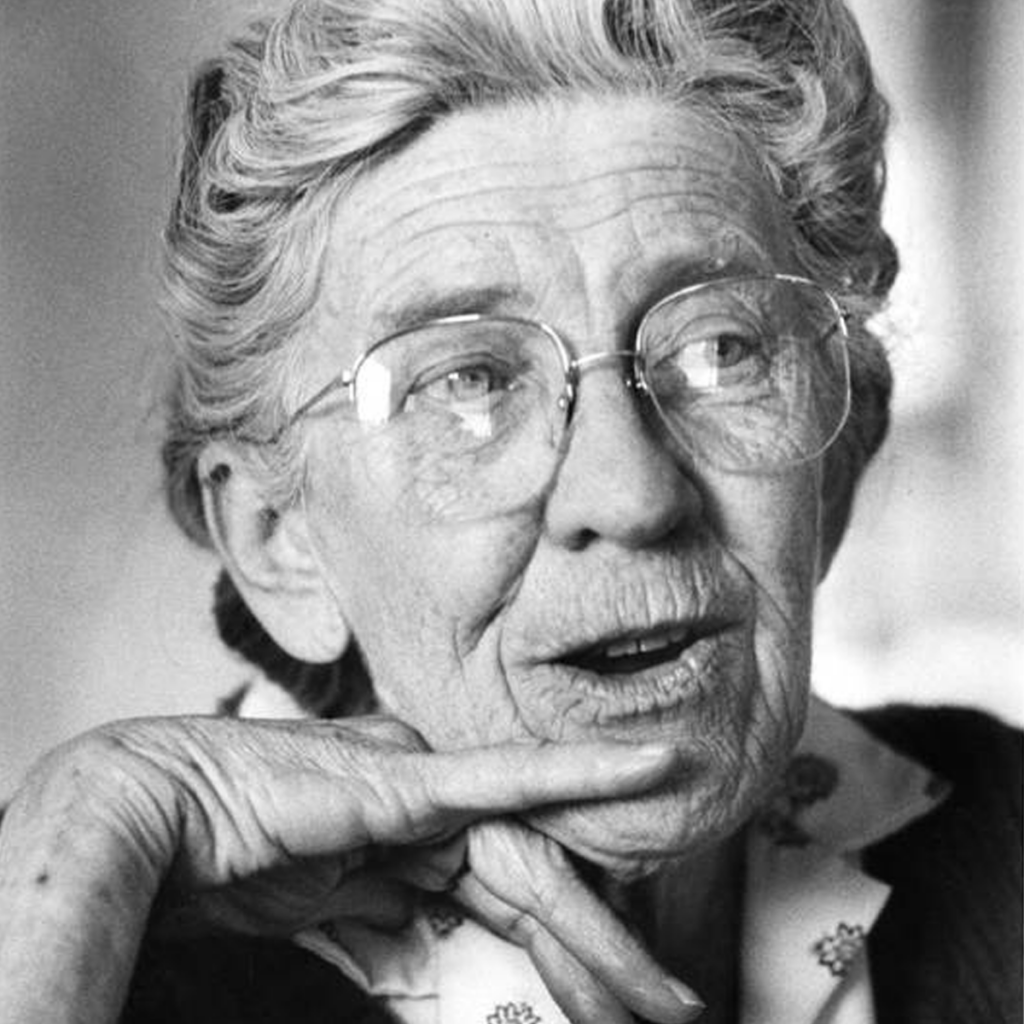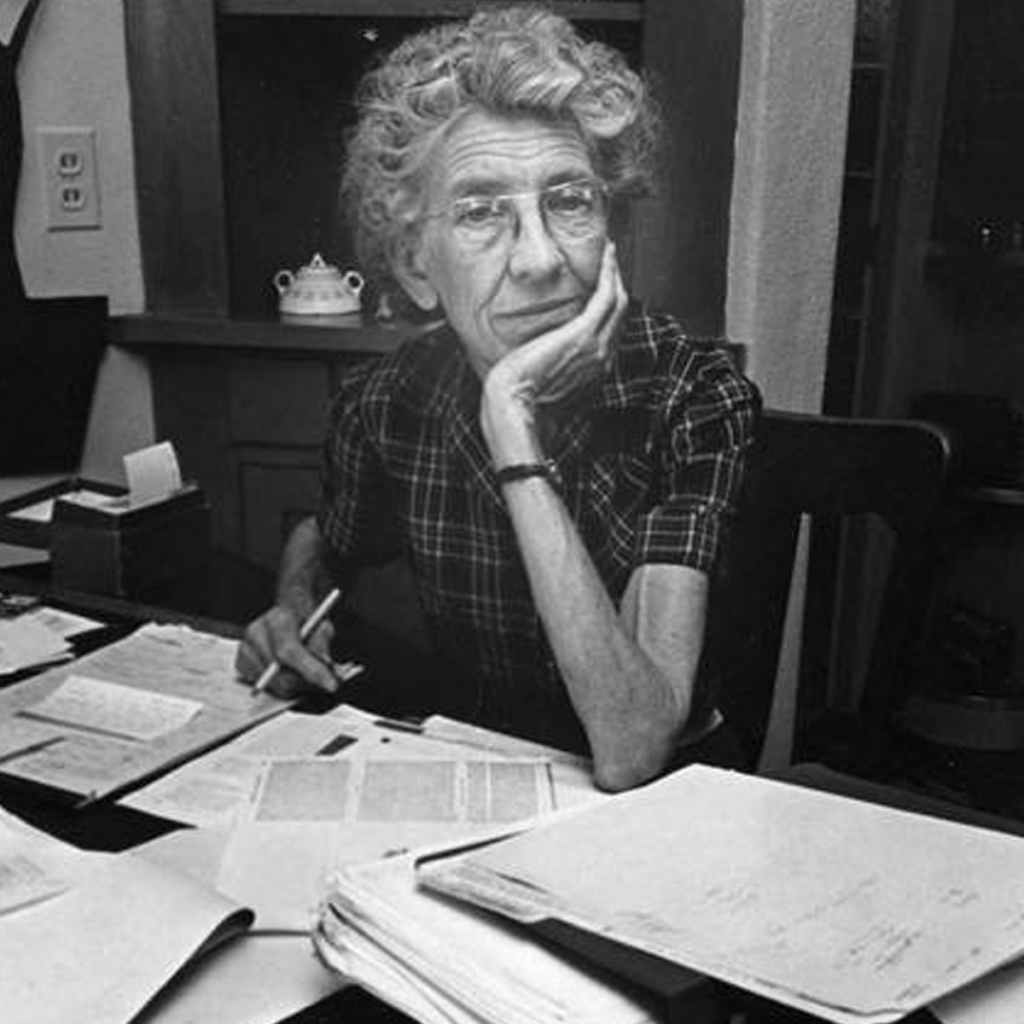Myra Ellen Jenkins
Photo Credit: Photographer: Leslie Tallant
Myra Ellen Jenkins
1916 - 1993
Santa Fe County
The first state historian, she was an authority and expert witness on Pueblo Indian issues and assisted many pueblos in trying to either retain or regain title to their ancestral lands. Teacher, scholar, and friend, her independent thinking, forthright opinions, feisty wit made an impact on all she met.
Myra Ellen Jenkins was born on September 26, 1916, in Elizabeth, Colorado, to Lewis Harlan Jenkins and Minnie (Ackroyd) Jenkins. Growing up in the Black Forest region, southeast of Denver and northeast of Colorado Springs, she was part of a family of homesteaders. She descended from English immigrants on her mother’s side, and her father was from Iowa. The land they worked together is still known as the Jenkins Ranch. Her grandfather had been to Santa Fe earlier in his life, working as a stonemason for a church, so stories he told while she was growing up in Colorado included his memories of Santa Fe.
She earned her bachelor’s degree in history from the University of Colorado in 1937 but because it was the depression, couldn’t get a job, so she continued on and earned a Master’s in history in 1938. She taught and served as a debate coach in the public school system in Colorado and went on to earn her Ph.D. in Latin American History from UNM in 1953. Thereafter, she was affectionately known as “Dr. J.”
After graduating from UNM, Myra Ellen went to work for the Museum of New Mexico in Santa Fe in the spring of 1960. She had been involved in the creation of the New Mexico State Records Center and Archives, and the Spanish and Mexican archives and the records center were at the museum. From the inception of the State Records Center and Archives in 1960 until her retirement twenty years later, Jenkins held the position of chief archivist for the state. That position, as described by an article in the Santa Fe New Mexican, is “responsible for managing and preserving the state’s archives and making them available for use by government agencies, business and the public.”
Her first job, as she described it, “was to clear out every cubbyhole, nook, and cranny of the old Roundhouse. Many documents had been put out for wastepaper.” Among the documents she helped preserve were the journals of Don Diego de Vargas, which had been improperly stored at the Palace of the Governors and were subsequently damaged by water.
In 1967, the state legislature designated that the state archivist also serve as the state historian and be a member of the State Commission on Historic Sites, which became the Cultural Properties Review Committee (CPRC) in 1969 with the passage of the State Cultural Properties Act. At that time, Dr. Jenkins became the first person to serve as State Historian, remaining in that office from 1967 until her retirement in 1980. As described on the website of the State Historian, “the mission of the Office of the State Historian is to foster and facilitate an appreciation and understanding of New Mexico history and culture through education, research, preservation, and community outreach.”
Dr. Jenkins had considerable influence in the area of tribal land matters. Described as enthusiastic, indefatigable, and always helpful and courteous, she was particularly helpful to those researching land grants and Indian land claims.
Her work in the field was summarized in 1993 by John Grassham, president of the Historical Society of New Mexico: “An authority and expert witness on Pueblo Indian issues since 1950, Myra Ellen assisted many pueblos in trying to either retain or regain title to their ancestral lands. Among these were Laguna, Acoma, Sandia, and Zuni pueblos. She was instrumental in helping the Pueblo of Taos regain title to Blue Lake. Myra Ellen was often called to give expert testimony on land grants and water rights.”
She published articles in El Palacio and the New Mexico Historical Review, many pertaining to land grants, and also authored a guide to the Spanish, Mexican, and Territorial archives in New Mexico. Among her publications, perhaps her most widely known is the book, A Brief History of New Mexico, which she co-authored with New Mexico archaeologist and ethno-historian Albert H. Schroeder. Published in 1974, the book is still in circulation and still serves as a reference to the history of the state. The publishing description reads: “No New Mexican should be without this useful volume, the first history of New Mexico in many years to be published with the official sanction of the state. The general reader, the newcomer to New Mexico, and the student will find remarkably detailed information here on every aspect of New Mexico’s past.”
During her time as state historian and after, Dr. Jenkins taught history courses as an instructor with St. Michael’s College in 1962 and 1963, at the College of Santa Fe from 1966 to 1974, at New Mexico State University in 1983, and as an adjunct professor at the University of New Mexico for several summer terms. She was a member of the Historical Society of New Mexico, the Western History Association, the Las Golondrinas Foundation, the Historic Santa Fe Foundation, and others.
Dr. Jenkins’s papers are in the collection of the Fort Lewis College Center of Southwest Studies in Durango, Colorado, described as a thorough research collection with a personal touch: Dr. J’s wonderful wit shines brightly throughout. A lifelong lover of history, she has left to researchers a treasure trove of materials, the main focus of which is the land and water rights of New Mexico’s Pueblo Indians. As one of the foremost voices on Spanish land grants, Dr. Jenkins was often an expert witness for the tribes in court, and was honored by several governors as a “friend of the Pueblos.”
The collection reflects Dr. Jenkins’ dedication to accuracy in the teaching of New Mexico’s history. She considered herself a scholar dedicated to complete honesty and refused any case that could not be supported by documentary research. As she put it, she “was not a hired gun.” For more than 60 years, she faithfully cut newspaper clippings and tucked them into her files, with notes of “NO WAY!” or “a deathless gem!” or “YES!” along with any documentation to support her stand: articles, essays, copies of archival material.
In June of 1986, she was honored as a Santa Fe Living Treasure. Her biography for that honor reads in part: “No ivory tower historian, “Dr. J.” frequently served as an expert historical witness who brought her knowledge of land grants into disputes on complex land and water rights issues entangled in three centuries of Spanish, Mexican, and American documents. Her 1947 book, A Brief History of New Mexico, co-authored with Al Schroeder, is still considered the most complete introduction to the state’s history. A great defender and protector of New Mexico’s heritage, she was responsible for keeping many documents within the state.” The nomination also notes that she made her reputation as the “final authority on New Mexico history,” and that Governor Bruce King called her “the most knowledgeable person in New Mexico about the state’s history.”
Dr. Myra Ellen Jenkins passed away at her home in Santa Fe on June 22, 1993. In describing Myra Ellen’s considerable influence on the state, John W. Grassham wrote on her passing, “From 1960 until her death, Myra Ellen has been thanked in the preface of nearly every book published on New Mexico history.”
Sources:
Bullis, Don. New Mexico: A Biographical Dictionary 1540-1980, Volume I. Los Ranchos de Albuquerque, NM: Rio Grande Books, 2007.
Drake, Tom, e-mail correspondence.
Fort Lewis College Center of Southwest Studies, https://swcenter.fortlewis.edu/finding_aids/inventory/Jenkins.htm, accessed March 14, 2017.
Gauntleroy, Gussie. “State Names New Chief Archivist.” The Santa Fe New Mexican, September 11, 1995, p. A-7.
Grassham, John W. “In Passing: Myra Ellen Jenkins, 1916-1993.” New Mexico Historical Review, October 1993.
Hart, E. Richard, ed. Zuni and the Courts: A Struggle for Sovereign Land Rights. Lawrence, KS: University Press of Kansas, 1995.
La Farge, John Pen. Turn Left at the Sleeping Dog: Scripting the Santa Fe Legend, 1920-1955. Albuquerque: University of New Mexico Press, 2001.
Office of the State Historian, http://www.newmexicohistory.org, accessed March 14, 2017.
Prabook (biographical directory), http://prabook.com/web/person-view.html?profileId=589556, accessed March 14, 2017.
Pueblo Central High School Hall of Fame, http://pueblocentral.org/HallOfHonor/2013/JenkinsMyra.htm, accessed March 14, 2017.
Santa Fe Living Treasures, http://sflivingtreasures.org/index.php/treasures/66-jenkins-myra-ellen-.html, accessed March 14, 2017.
Woodbury, Nathalie F. S., “Death Notices: Myra Ellen Jenkins.” Anthropology Newsletter, September 1993.








